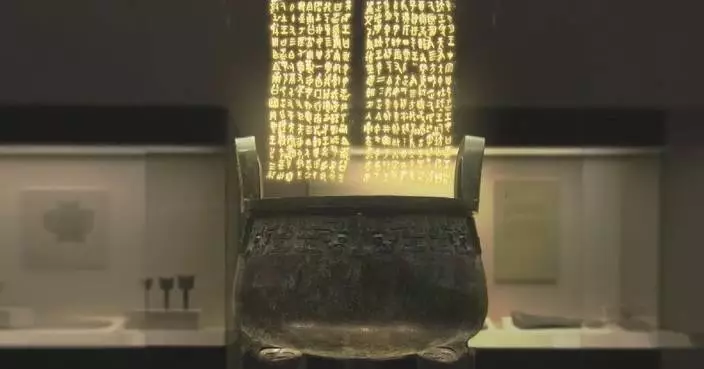Cantonese Embroidery, an intricate art form with a history dating back to over 1,300 years, is being revitalized through the efforts of its intangible heritage inheritor Wang Xinyuan, who is dedicated to promoting China's rich cultural heritage on a global scale.
As one of China's four major schools of embroidery, "Guang Xiu," the traditional handicraft, is now playing a vital role in China's pursuit of cultural confidence.
In a quiet studio in Guangzhou, the master craftsman leans over an embroidery frame, his skilled hands weaving threads finer than a human hair and creating vibrant, life-like images.
Wang entered the world of embroidery when he was just 13 years old. But it wasn't until 2001 that he met his mentor in Guangzhou and began professional training.
"There was no subway back then, so I had to take a seven-hour bus ride every time I went to see my mentor. It was exhausting for sure, spending seven or eight hours a day on a piece, not knowing if it would ever pay off. (My passion) probably also gave me the perseverance," Wang said.
Bringing embroidery into the modern age is challenging. To keep this heritage alive, it can't remain a luxury art item on the walls - it needs to become a part of everyday life through fashion, home decoration, and gifts.
Wang has expanded the scope of Cantonese embroidery by incorporating national treasures, western masterpieces, and even modern landscapes.
"Western paintings focus on the colors and perspectives. In terms of numbers, some oil painting require over 1,800 or even 3,000 colors. Cantonese embroidery has long had western audience when it was exported overseas. I hope to find a way to not only revive its glory in the Qing (1636-1912) or Ming Dynasty (1368-1644) but also to take it even further," he said.
Wang's expertise has taken him around the world, from Switzerland and Italy to New Zealand, where he shares this ancient craft with new audiences. Back home, his studios welcome students from all walks of life.
"I think it's a beautiful culture, and you can see the traditional styles, but you also can see how it's still kept alive in a new modern way," said Christine, a Brazilian designer.
The story about Wang Xinyuan is part of a larger effort across China to preserve, elevate, and share cultural traditions with the world, ensuring they thrive in the modern age.

Cantonese embroidery master gives new life to ancient art
Russia claimed on Monday that it had taken control of one more settlement as part of its ongoing offensive in the Donetsk region, while Ukraine, on the same day, reported repelling multiple Russian attacks.
The Russian Defense Ministry said in a briefing that over past 24 hours, its forces captured the village of Novoolenovka in Ukraine's eastern Donetsk region, located about 17 kilometers southwest of the city of Pokrovsk, a key front in Moscow's offensive in the region.
The Russian forces launched attacks on multiple Ukrainian military airfields, military-industrial energy facilities, weapons and ammunition depots, and drone command centers, the ministry said.
Furthermore, the Russian air defense forces intercepted four U.S.-made HIMARS rockets and shot down 65 drones, it said.
Meanwhile, the General Staff of the Ukrainian Armed Forces reported that as of Monday afternoon, there had been 104 fights on the front lines, the situation remains tense, with Ukrainian forces continuing to repel Russian offensives, resulting in casualties and equipment losses on the Russian side.
According to Ukrainian media reports, Ukrainian forces discovered and destroyed a Russian military command post in the Zaporizhzhia region.
In another development, the Russian Ministry of Defense announced on Monday on social media that Russia and Ukraine had once again exchanged a group of detained individuals on that day.
The ministry said that after negotiations, 150 Russian soldiers have been returned to Russia from territories controlled by Ukraine. All the exchanged Russian soldiers are currently receiving necessary medical care and psychological counseling in Belarus. They will be transported back to Russia to receive further treatment at Russian military medical facilities.
Also on Monday, Ukrainian President Volodymyr Zelensky said on Telegram that a total of 189 Ukrainians returned from Russian captivity. Among those released were 187 servicemen, including officers, soldiers and sergeants, along with two civilians.
The freed troops included military personnel who fought for the Chernobyl nuclear power plant, the city of Mariupol, and the Snake Island in the Black Sea, Zelensky added.
On Monday, the United States announced that it would provide nearly 2.5 billion U.S. dollars in additional military support to Ukraine.
According to the U.S. Department of Defense, since President Joe Biden took office, the total amount of U.S. military support to Ukraine has exceeded 66 billion U.S. dollars. Since the outbreak of the Russia-Ukraine conflict, U.S. military assistance to Ukraine has reached 65.4 billion U.S. dollars.
Russia has repeatedly warned that the continuous supply of weapons to Ukraine by Western countries is a provocative act that could escalate the conflict further.

Russia seizes one more settlement in Ukraine's Donetsk, Ukraine repels Russian attacks










